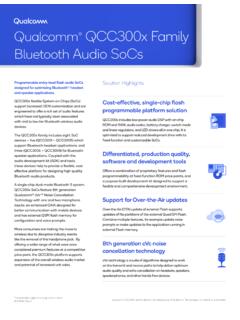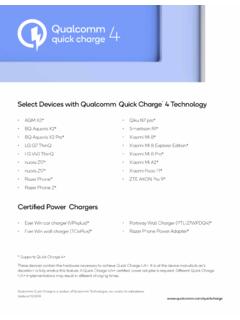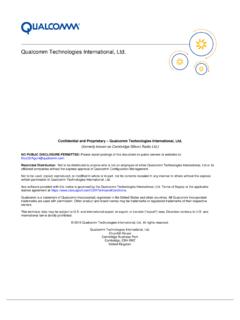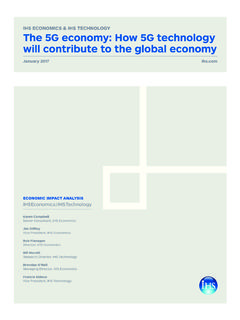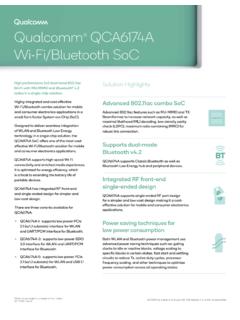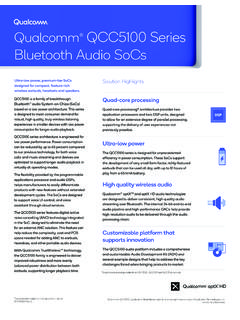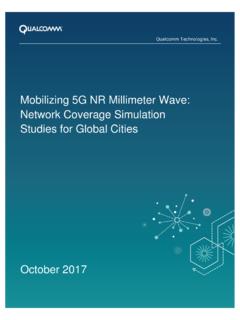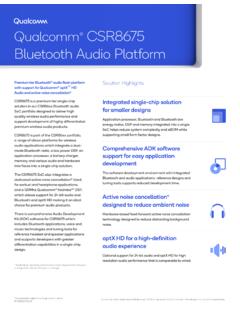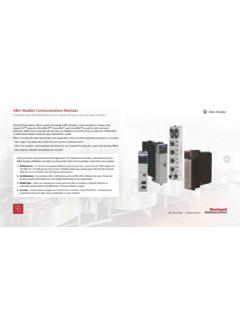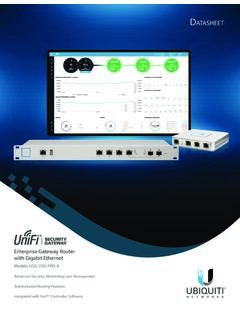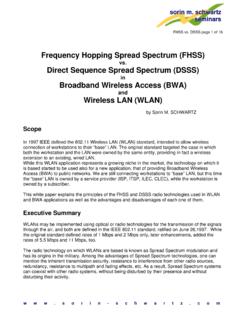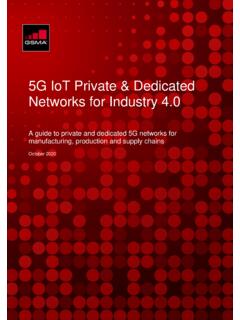Transcription of Private LTE Networks - Wireless Technology & Innovation
1 Independent market research and competitive analysis of next-generation business and Technology solutions for service providers and vendors Private LTE Networks A Heavy Reading white paper produced for Qualcomm Inc. AUTHOR: GABRIEL BROWN, PRINCIPAL ANALYST, HEAVY READING HEAVY READING | JULY 2017 | Private LTE Networks 2 Private LTE Networks : A NEW ENTERPRISE ENABLER Today's progressive enterprises, in virtually all industrial sectors, are pursuing software-driven operating models using analytics, automation and machine communications to improve productivity. These processes are underpinned by new-wave Wireless networking solutions that offer scalable control and extreme reliability in very dense, machine-oriented environ-ments.
2 From Industry factory-floor automation, to control of autonomous trucks in open cast mines, to electricity distribution grids, to logistics and warehousing, to venue services, and many more use cases, Wireless Networks are essential to real-time process automation and can unleash phenomenal productivity benefits. This white paper will discuss why LTE is now a highly attractive Technology for Private wire-less Networks across a wide range of enterprise verticals. It addresses the performance attrib-utes of the LTE radio and system architecture and how the global LTE ecosystem makes it possible for Private organizations to deploy and operate high-performance Networks without dependency on licensed mobile operators.
3 It argues that LTE is now the preferred Wireless platform for enterprises with production-critical automation and mobility needs. Organizations that control their own networking environment can more easily modify the Technology and optimize it for their own purposes for example, for fast recovery from fail-ure, extended range coverage, or specific prioritization and reliability schemes. The availa-bility of open access spectrum, notably the shared access GHz band in the and the 5 GHz unlicensed band globally, in combination with built-for-purpose equipment, now make it possible for almost any organization to deploy and operate a Private LTE network .
4 However, the ongoing contribution of licensed mobile operators to Private Wireless Networks should not be overlooked. There remain many opportunities to deploy Private Networks in licensed spectrum, to offer Private LTE as a managed service, or to extend Private local-area Networks across the wide-area public network to create enterprise-specific VPNs. Who Needs Private Wireless Networks ? Organizations that can generate the greatest benefit from Private LTE have use cases that are not readily supported on public Networks . Once the use case is established, and perfor-mance requirements are known, the primary reasons to deploy a Private network are: Coverage: Organizations can guarantee coverage at their facility or location by in-stalling their own network .
5 This is most necessary where public Networks do not exist or are not robust (in remote areas, , mines or agricultural lands), but can often also apply to indoor and campus locations ( , factories, warehouses, power plants, etc.) Capacity: Without contention with other network users, enterprises can make full and exclusive use of available capacity. They can configure uplink and downlink, set usage policy and engineer the RAN according to their specific capacity demands for example, to support HD video streaming and analysis for, say, a security application. Control: Private operators can determine which users connect, how resources are utilized and how traffic is prioritized.
6 If needed, parameters in the LTE radio can be customized to optimize reliability and latency in challenging physical environments ( , warehouse or oil/gas facility with lots of metal). This is unthinkable on the public network . Companies can also control their own security to ensure that sensitive infor-mation doesn't leave the premises essential to many types of high-tech businesses. HEAVY READING | JULY 2017 | Private LTE Networks 3 In general, Private LTE Networks are designed with machine communications as the primary user in mind. Nevertheless, one of the strengths of LTE is a multiservice capability that sup-ports, for example, low-bit-rate Internet of Things (IoT), critical control signaling ( , for programmable logic controllers) and human smartphone users on a common infrastructure.
7 Examples of use cases where reliability and performance are critical are shown in Figure 1. Figure 1: Example Use Cases for Private 4G Networks Use Case Type Description Automation & Industry Factory-floor robotics , Wireless robots introduce much greater flexi-bility to reconfigure production lines Logistics and warehousing , pick-and-pack machines; often consid-ered under the banner of "Industry " Typically focused very dense deployments with low latency requirements Mission-Critical Services To monitor and control critical infrastructure , electricity distribution grids, power plants, etc. Public safety agencies often need to create closed user group ad hoc net-works at the scene of emergency Government & military agencies want dedicated, highly available Networks at their facilities , the Finnish government has pioneered this model Primary Industries Locations often not covered by public Wireless infrastructure Very diverse sector from mining to agriculture, making increasing use of automated machinery Often requires hardened equipment with good link budget for low-density long-range coverage Venue Services Public venues such as airports, stadiums, hospitals, ports These venues have many users (internal.)
8 Contractor, public), some of which have requirements for fast, highly secure access Private network can be "sliced" (configured) for different user groups Source: Heavy Reading Advantages of LTE for Private Wireless Networks Most Private Wireless Networks today use WiFi. This is fast and easy to deploy, there is a competitive market for equipment, and a feature-rich roadmap. In many cases, WiFi will remain a good solution. Private LTE is based on technologies developed for wide-area mobility and scaled down to be deployable by Private organizations. This background gives LTE some advantages over WiFi, particularly as relates to radio performance and mobility, that can help meet more demanding use cases.
9 These advantages include: Range/Link Budget: LTE systems are generally developed and deployed using RF equipment with higher specification, which extends the link budget considerably. As LTE is a cellular Technology , it has been designed to operate well under fading chan-nel conditions, providing good cell edge performance. As a very approximate rule of thumb, one LTE small cell will cover about the same area as two to three WiFi access points at more or less equivalent power output. If CBRS GHz spectrum and Cate-gory-B small cells are used, range can be significantly greater still. Spectral Efficiency/Capacity: Many of the concepts that improve range and relia-bility also increase spectral efficiency.
10 LTE is more spectrally efficient than WiFi (more HEAVY READING | JULY 2017 | Private LTE Networks 4 than double, according to some analyses) because of higher efficiencies at both link and MAC level from concepts such as hybrid automatic repeat request (ARQ) with channel state information, more granular modulation and coding schemes and more adaptable schedulers (compared to WiFi). LTE is designed for mobility and outdoor operation, and with concepts such as long cyclic prefix, it can handle larger delay spreads, which also contributes to overall spectral efficiency. Configurable QoS: The LTE QoS model allows for multiple layers of prioritization.
